Contents
Acknowledgments
Notation
1 Introduction
1.1 Who Should Read This Book? . . . . . . . . . . . . . . . . . . . .
1.2 Historical Trends in Deep Learning . . . . . . . . . . . . . . . . .
I Applied Math and Machine Learning Basics
2 Linear Algebra
Scalars, Vectors, Matrices and Tensors . . . . . . . . . . . . . . .
2.1
2.2 Multiplying Matrices and Vectors . . . . . . . . . . . . . . . . . .
Identity and Inverse Matrices . . . . . . . . . . . . . . . . . . . .
2.3
2.4
Linear Dependence, Span and Rank . . . . . . . . . . . . . . . .
2.5 Norms . . . . . . . . . . . . . . . . . . . . . . . . . . . . . . . . .
Special Kinds of Matrices and Vectors
2.6
. . . . . . . . . . . . . . .
2.7
Eigendecomposition . . . . . . . . . . . . . . . . . . . . . . . . . .
Singular Value Decomposition . . . . . . . . . . . . . . . . . . . .
2.8
2.9
The Moore-Penrose Pseudoinverse
. . . . . . . . . . . . . . . . .
2.10 The Trace Operator
. . . . . . . . . . . . . . . . . . . . . . . . .
2.11 Determinant . . . . . . . . . . . . . . . . . . . . . . . . . . . . . .
. . . . . . . . . . . . .
2.12 Example: Principal Components Analysis
3 Probability and Information Theory
3.1 Why Probability? . . . . . . . . . . . . . . . . . . . . . . . . . . .
Random Variables
3.2
. . . . . . . . . . . . . . . . . . . . . . . . . .
3.3
Probability Distributions . . . . . . . . . . . . . . . . . . . . . . .
3.4 Marginal Probability . . . . . . . . . . . . . . . . . . . . . . . . .
3.5
Conditional Probability . . . . . . . . . . . . . . . . . . . . . . .
i
vii
ix
1
8
11
26
28
28
30
32
33
35
36
37
40
41
42
43
43
48
48
51
51
53
53
�
CONTENTS
The Chain Rule of Conditional Probabilities . . . . . . . . . . . .
3.6
Independence and Conditional Independence
. . . . . . . . . . .
3.7
Expectation, Variance and Covariance . . . . . . . . . . . . . . .
3.8
Information Theory . . . . . . . . . . . . . . . . . . . . . . . . . .
3.9
3.10 Common Probability Distributions . . . . . . . . . . . . . . . . .
3.11 Useful Properties of Common Functions . . . . . . . . . . . . . .
3.12 Bayes’ Rule . . . . . . . . . . . . . . . . . . . . . . . . . . . . . .
3.13 Technical Details of Continuous Variables
. . . . . . . . . . . . .
3.14 Structured Probabilistic Models . . . . . . . . . . . . . . . . . . .
3.15 Example: Naive Bayes . . . . . . . . . . . . . . . . . . . . . . . .
4 Numerical Computation
4.1 Overflow and Underflow . . . . . . . . . . . . . . . . . . . . . . .
4.2
Poor Conditioning . . . . . . . . . . . . . . . . . . . . . . . . . .
4.3 Gradient-Based Optimization . . . . . . . . . . . . . . . . . . . .
Constrained Optimization . . . . . . . . . . . . . . . . . . . . . .
4.4
4.5
Example: Linear Least Squares . . . . . . . . . . . . . . . . . . .
54
54
55
56
59
65
66
67
68
71
77
77
78
79
88
90
5 Machine Learning Basics
92
92
Learning Algorithms . . . . . . . . . . . . . . . . . . . . . . . . .
5.1
5.2
Example: Linear Regression . . . . . . . . . . . . . . . . . . . . . 100
5.3 Generalization, Capacity, Overfitting and Underfitting . . . . . . 103
5.4 Hyperparameters and Validation Sets . . . . . . . . . . . . . . . . 113
5.5
Estimators, Bias and Variance . . . . . . . . . . . . . . . . . . . . 115
5.6 Maximum Likelihood Estimation . . . . . . . . . . . . . . . . . . 123
5.7
. . . . . . . . . . . . . . . . . . . . . . . . . . 126
Bayesian Statistics
5.8
Supervised Learning Algorithms . . . . . . . . . . . . . . . . . . . 133
5.9 Unsupervised Learning Algorithms . . . . . . . . . . . . . . . . . 138
5.10 Weakly Supervised Learning . . . . . . . . . . . . . . . . . . . . . 141
5.11 Building a Machine Learning Algorithm . . . . . . . . . . . . . . 142
5.12 The Curse of Dimensionality and Statistical Limitations of Local
Generalization . . . . . . . . . . . . . . . . . . . . . . . . . . . . . 143
II Modern Practical Deep Networks
155
6 Feedforward Deep Networks
157
6.1 Vanilla MLPs . . . . . . . . . . . . . . . . . . . . . . . . . . . . . 158
6.2
Estimating Conditional Statistics . . . . . . . . . . . . . . . . . . 162
Parametrizing a Learned Predictor . . . . . . . . . . . . . . . . . 162
6.3
6.4
Flow Graphs and Back-Propagation . . . . . . . . . . . . . . . . 174
ii
�
CONTENTS
6.5 Universal Approximation Properties and Depth . . . . . . . . . . 188
Feature / Representation Learning . . . . . . . . . . . . . . . . . 191
6.6
6.7
Piecewise Linear Hidden Units
. . . . . . . . . . . . . . . . . . . 192
6.8 Historical Notes . . . . . . . . . . . . . . . . . . . . . . . . . . . . 194
7 Regularization of Deep or Distributed Models
196
Regularization from a Bayesian Perspective . . . . . . . . . . . . 198
7.1
Classical Regularization: Parameter Norm Penalty . . . . . . . . 199
7.2
Classical Regularization as Constrained Optimization . . . . . . . 207
7.3
7.4
Regularization and Under-Constrained Problems
. . . . . . . . . 208
7.5 Dataset Augmentation . . . . . . . . . . . . . . . . . . . . . . . . 210
Classical Regularization as Noise Robustness
7.6
. . . . . . . . . . . 211
Early Stopping as a Form of Regularization . . . . . . . . . . . . 217
7.7
7.8
Parameter Tying and Parameter Sharing . . . . . . . . . . . . . . 223
7.9
Sparse Representations . . . . . . . . . . . . . . . . . . . . . . . . 224
7.10 Bagging and Other Ensemble Methods . . . . . . . . . . . . . . . 226
7.11 Dropout . . . . . . . . . . . . . . . . . . . . . . . . . . . . . . . . 227
7.12 Multi-Task Learning . . . . . . . . . . . . . . . . . . . . . . . . . 232
7.13 Adversarial Training . . . . . . . . . . . . . . . . . . . . . . . . . 234
8 Optimization for Training Deep Models
236
8.1 Optimization for Model Training . . . . . . . . . . . . . . . . . . 236
8.2
Challenges in Optimization . . . . . . . . . . . . . . . . . . . . . 241
. . . . . . . . . . . 250
8.3 Optimization Algorithms I: Basic Algorithms
8.4 Optimization Algorithms II: Adaptive Learning Rates
. . . . . . 256
8.5 Optimization Algorithms III: Approximate Second-Order Methods261
8.6 Optimization Algorithms IV: Natural Gradient Methods . . . . . 262
8.7 Optimization Strategies and Meta-Algorithms . . . . . . . . . . . 262
8.8 Hints, Global Optimization and Curriculum Learning . . . . . . . 270
9 Convolutional Networks
Pooling
Convolution and Pooling as an Infinitely Strong Prior
274
9.1
The Convolution Operation . . . . . . . . . . . . . . . . . . . . . 275
9.2 Motivation . . . . . . . . . . . . . . . . . . . . . . . . . . . . . . . 278
. . . . . . . . . . . . . . . . . . . . . . . . . . . . . . . . 282
9.3
9.4
. . . . . . 287
9.5 Variants of the Basic Convolution Function . . . . . . . . . . . . 288
Structured Outputs . . . . . . . . . . . . . . . . . . . . . . . . . . 295
9.6
9.7
Convolutional Modules . . . . . . . . . . . . . . . . . . . . . . . . 295
9.8 Data Types . . . . . . . . . . . . . . . . . . . . . . . . . . . . . . 295
Efficient Convolution Algorithms . . . . . . . . . . . . . . . . . . 297
9.9
9.10 Random or Unsupervised Features
. . . . . . . . . . . . . . . . . 298
iii
�
CONTENTS
9.11 The Neuroscientific Basis for Convolutional Networks . . . . . . . 299
9.12 Convolutional Networks and the History of Deep Learning . . . . 305
10 Sequence Modeling: Recurrent and Recursive Nets
308
10.1 Unfolding Flow Graphs and Sharing Parameters . . . . . . . . . . 309
10.2 Recurrent Neural Networks
. . . . . . . . . . . . . . . . . . . . . 311
10.3 Bidirectional RNNs . . . . . . . . . . . . . . . . . . . . . . . . . . 322
10.4 Encoder-Decoder Sequence-to-Sequence Architectures
. . . . . . 323
. . . . . . . . . . . . . . . . . . . . . . 325
10.5 Deep Recurrent Networks
10.6 Recursive Neural Networks
. . . . . . . . . . . . . . . . . . . . . 326
10.7 Auto-Regressive Networks . . . . . . . . . . . . . . . . . . . . . . 328
10.8 Facing the Challenge of Long-Term Dependencies . . . . . . . . . 334
10.9 Handling Temporal Dependencies with n-grams, HMMs, CRFs
and Other Graphical Models . . . . . . . . . . . . . . . . . . . . . 347
10.10 Combining Neural Networks and Search . . . . . . . . . . . . . . 358
11 Practical methodology
364
11.1 Basic Machine Learning Methodology . . . . . . . . . . . . . . . 364
11.2 Selecting Hyperparameters . . . . . . . . . . . . . . . . . . . . . . 365
11.3 Debugging Strategies . . . . . . . . . . . . . . . . . . . . . . . . . 373
12 Applications
376
12.1 Large Scale Deep Learning . . . . . . . . . . . . . . . . . . . . . . 376
12.2 Computer Vision . . . . . . . . . . . . . . . . . . . . . . . . . . . 384
12.3 Speech Recognition . . . . . . . . . . . . . . . . . . . . . . . . . . 391
12.4 Natural Language Processing and Neural Language Models
. . . 393
12.5 Structured Outputs . . . . . . . . . . . . . . . . . . . . . . . . . . 408
12.6 Other Applications . . . . . . . . . . . . . . . . . . . . . . . . . . 409
III Deep Learning Research
410
13 Structured Probabilistic Models for Deep Learning
412
13.1 The Challenge of Unstructured Modeling . . . . . . . . . . . . . . 413
13.2 Using Graphs to Describe Model Structure . . . . . . . . . . . . . 417
13.3 Advantages of Structured Modeling . . . . . . . . . . . . . . . . . 431
13.4 Learning About Dependencies . . . . . . . . . . . . . . . . . . . . 432
13.5 Inference and Approximate Inference Over Latent Variables . . . 434
13.6 The Deep Learning Approach to Structured Probabilistic Models 435
14 Monte Carlo Methods
440
14.1 Markov Chain Monte Carlo Methods . . . . . . . . . . . . . . . . 440
iv
�
CONTENTS
14.2 The Difficulty of Mixing Between Well-Separated Modes . . . . . 442
15 Linear Factor Models and Auto-Encoders
444
15.1 Regularized Auto-Encoders
. . . . . . . . . . . . . . . . . . . . . 445
15.2 Denoising Auto-encoders . . . . . . . . . . . . . . . . . . . . . . . 448
15.3 Representational Power, Layer Size and Depth . . . . . . . . . . 450
15.4 Reconstruction Distribution . . . . . . . . . . . . . . . . . . . . . 451
15.5 Linear Factor Models . . . . . . . . . . . . . . . . . . . . . . . . . 452
15.6 Probabilistic PCA and Factor Analysis . . . . . . . . . . . . . . . 453
15.7 Reconstruction Error as Log-Likelihood . . . . . . . . . . . . . . 457
15.8 Sparse Representations . . . . . . . . . . . . . . . . . . . . . . . . 458
. . . . . . . . . . . . . . . . . . . . . . 463
15.9 Denoising Auto-Encoders
15.10 Contractive Auto-Encoders
. . . . . . . . . . . . . . . . . . . . . 468
16 Representation Learning
471
16.1 Greedy Layerwise Unsupervised Pre-Training . . . . . . . . . . . 472
16.2 Transfer Learning and Domain Adaptation . . . . . . . . . . . . . 479
16.3 Semi-Supervised Learning . . . . . . . . . . . . . . . . . . . . . . 486
16.4 Semi-Supervised Learning and Disentangling Underlying Causal
Factors . . . . . . . . . . . . . . . . . . . . . . . . . . . . . . . . . 487
16.5 Assumption of Underlying Factors and Distributed Representation489
16.6 Exponential Gain in Representational Efficiency from Distributed
Representations . . . . . . . . . . . . . . . . . . . . . . . . . . . . 493
16.7 Exponential Gain in Representational Efficiency from Depth . . . 495
16.8 Priors Regarding The Underlying Factors
. . . . . . . . . . . . . 497
17 The Manifold Perspective on Representation Learning
501
17.1 Manifold Interpretation of PCA and Linear Auto-Encoders
. . . 509
17.2 Manifold Interpretation of Sparse Coding . . . . . . . . . . . . . 512
17.3 The Entropy Bias from Maximum Likelihood . . . . . . . . . . . 512
17.4 Manifold Learning via Regularized Auto-Encoders
. . . . . . . . 513
17.5 Tangent Distance, Tangent-Prop, and Manifold Tangent Classifier 514
18 Confronting the Partition Function
518
18.1 The Log-Likelihood Gradient of Energy-Based Models
. . . . . . 519
18.2 Stochastic Maximum Likelihood and Contrastive Divergence . . . 521
18.3 Pseudolikelihood . . . . . . . . . . . . . . . . . . . . . . . . . . . 528
18.4 Score Matching and Ratio Matching . . . . . . . . . . . . . . . . 530
18.5 Denoising Score Matching . . . . . . . . . . . . . . . . . . . . . . 532
18.6 Noise-Contrastive Estimation . . . . . . . . . . . . . . . . . . . . 532
18.7 Estimating the Partition Function . . . . . . . . . . . . . . . . . 534
v
�
CONTENTS
19 Approximate inference
542
19.1 Inference as Optimization . . . . . . . . . . . . . . . . . . . . . . 544
19.2 Expectation Maximization . . . . . . . . . . . . . . . . . . . . . . 545
19.3 MAP Inference: Sparse Coding as a Probabilistic Model
. . . . . 546
19.4 Variational Inference and Learning . . . . . . . . . . . . . . . . . 547
19.5 Stochastic Inference
. . . . . . . . . . . . . . . . . . . . . . . . . 551
19.6 Learned Approximate Inference . . . . . . . . . . . . . . . . . . . 551
20 Deep Generative Models
553
20.1 Boltzmann Machines . . . . . . . . . . . . . . . . . . . . . . . . . 553
20.2 Restricted Boltzmann Machines . . . . . . . . . . . . . . . . . . . 556
20.3 Training Restricted Boltzmann Machines . . . . . . . . . . . . . . 559
20.4 Deep Belief Networks . . . . . . . . . . . . . . . . . . . . . . . . . 563
20.5 Deep Boltzmann Machines . . . . . . . . . . . . . . . . . . . . . . 566
20.6 Boltzmann Machines for Real-Valued Data . . . . . . . . . . . . . 577
20.7 Convolutional Boltzmann Machines . . . . . . . . . . . . . . . . . 580
20.8 Other Boltzmann Machines
. . . . . . . . . . . . . . . . . . . . . 581
. . . . . . . . . . . . . . . . . . . . . . 581
20.9 Directed Generative Nets
20.10 A Generative View of Autoencoders
. . . . . . . . . . . . . . . . 583
20.11 Generative Stochastic Networks . . . . . . . . . . . . . . . . . . . 589
20.12 Methodological Notes . . . . . . . . . . . . . . . . . . . . . . . . . 591
Bibliography
Index
595
637
vi
�
Acknowledgments
This book would not have been possible without the contributions of many people.
We would like to thank those who commented on our proposal for the book
and helped plan its contents and organization: Hugo Larochelle, Guillaume Alain,
Kyunghyun Cho, C¸ a˘glar G¨ul¸cehre, Razvan Pascanu, David Krueger and Thomas
Roh´ee.
We would like to thank the people who offered feedback on the content of
the book itself. Some offered feedback on many chapters: Julian Serban, Laurent
Dinh, Guillaume Alain, Kelvin Xu, Meire Fortunato, Ilya Sutskever, Vincent
Vanhoucke, David Warde-Farley, Augustus Q. Odena, Matko Boˇsnjak, Stephan
Dreseitl, Jurgen Van Gael, Dustin Webb, Johannes Roith, Ion Androutsopoulos,
Stephan Dreiseitl, Karl Pichotta, Pawel Chilinski, Halis Sak, Fr´ed´eric Francis,
Jonathan Hunt, and Grigory Sapunov.
individual chapters:
We would also like to thank those who provided us with useful feedback on
•
Chapter 1, Introduction: Johannes Roith, Eric Morris, Samira Ebrahimi,
Ozan C¸ a˘glayan, Mart´ın Abadi, and Sebastien Bratieres.
•
•
•
•
•
•
Chapter 2, Linear Algebra: Pierre Luc Carrier, Li Yao, Thomas Roh´ee,
Colby Toland, Amjad Almahairi, Sergey Oreshkov, Istv´an Petr´as, Dennis
Prangle, and Alessandro Vitale.
Chapter 3, Probability and Information Theory: Rasmus Antti, Stephan
Gouws, Vincent Dumoulin, Artem Oboturov, Li Yao, John Philip Anderson,
and Kai Arulkumaran.
Chapter 4, Numerical Computation: Tran Lam An.
Chapter 5, Machine Learning Basics: Dzmitry Bahdanau, and Zheng Sun.
Chapter 6, Feedforward Deep Networks: David Krueger.
Chapter 8, Optimization for Training Deep Models: James Martens and
Marcel Ackermann.
vii
�
CONTENTS
•
•
•
•
•
Chapter 9, Convolutional Networks: Mehdi Mirza, C¸ a˘glar G¨ul¸cehre, and
Mart´ın Arjovsky.
Chapter 10, Sequence Modeling: Recurrent and Recursive Nets: Mihaela
Rosca, Razvan Pascanu, Dmitriy Serdyuk, and Dongyu Shi.
Chapter 18, Confronting the Partition Function: Sam Bowman, and Ozan
C¸ a˘glayan.
Chapter 20, Deep Generative Models: Fady Medhat
Bibliography, Leslie N. Smith.
We also want to thank those who allowed us to reproduce images, figures
or data from their publications: David Warde-Farley, Matthew D. Zeiler, Rob
Fergus, Chris Olah, Jason Yosinski, Nicolas Chapados and James Bergstra. We
indicate their contributions in the figure captions throughout the text.
Finally, we would like to thank Google for allowing Ian Goodfellow to work
on the book as his 20% project while working at Google. In particular, we would
like to thank Ian’s former manager, Greg Corrado, and his subsequent manager,
Samy Bengio, for their support of this effort.
viii
�
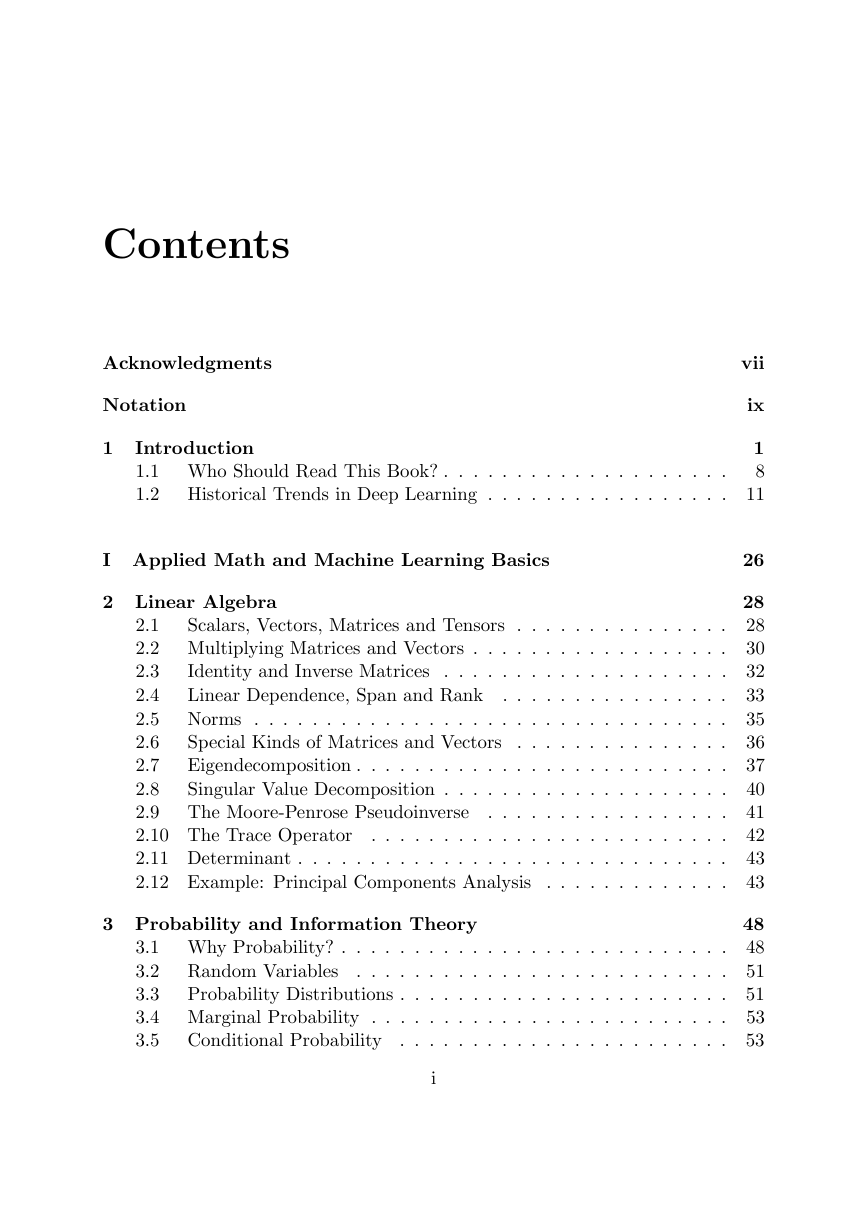

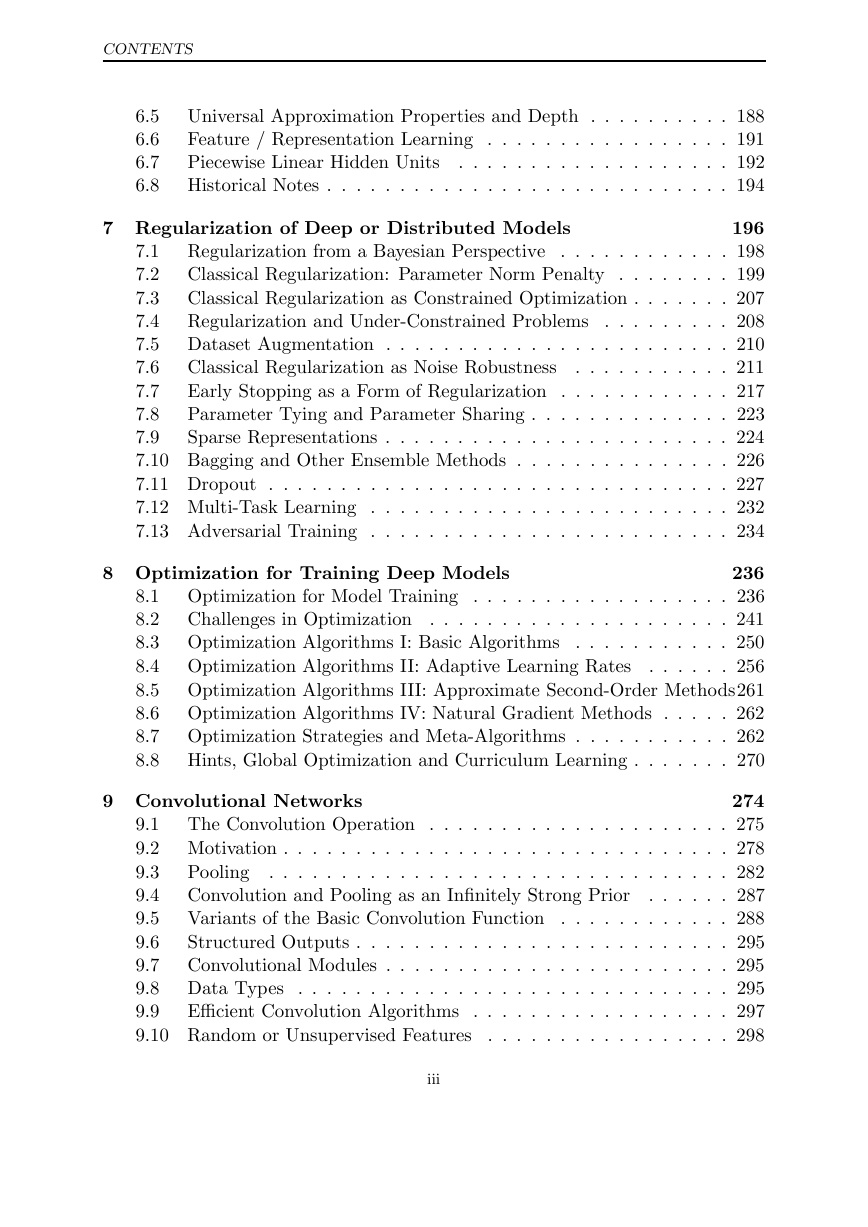
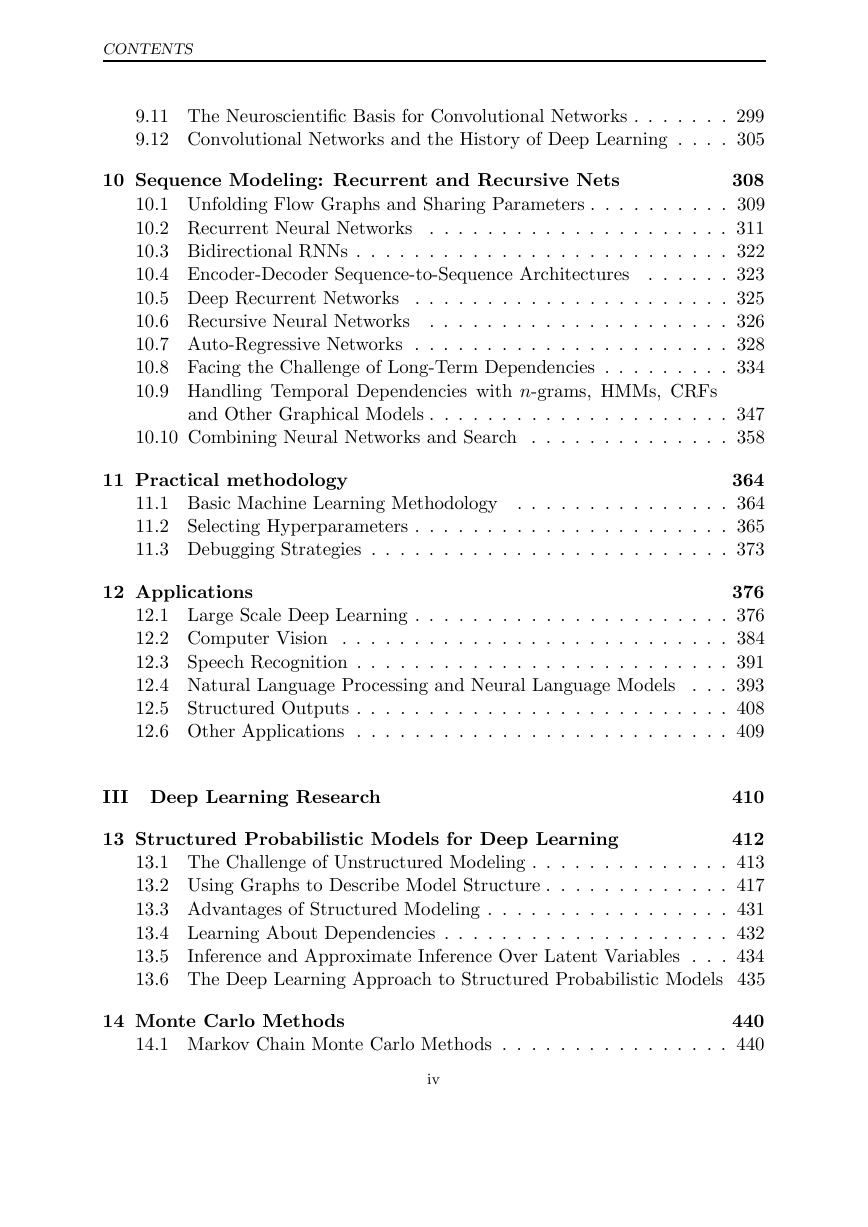
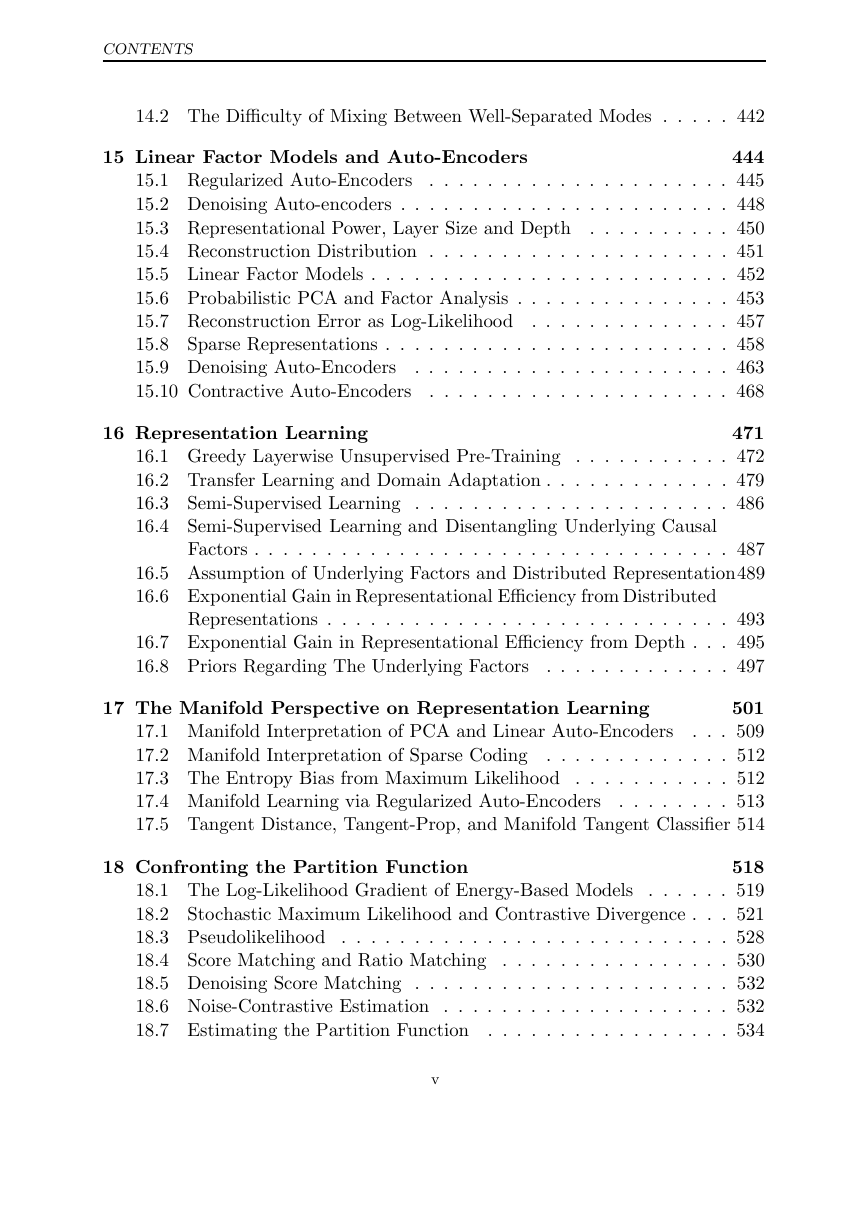

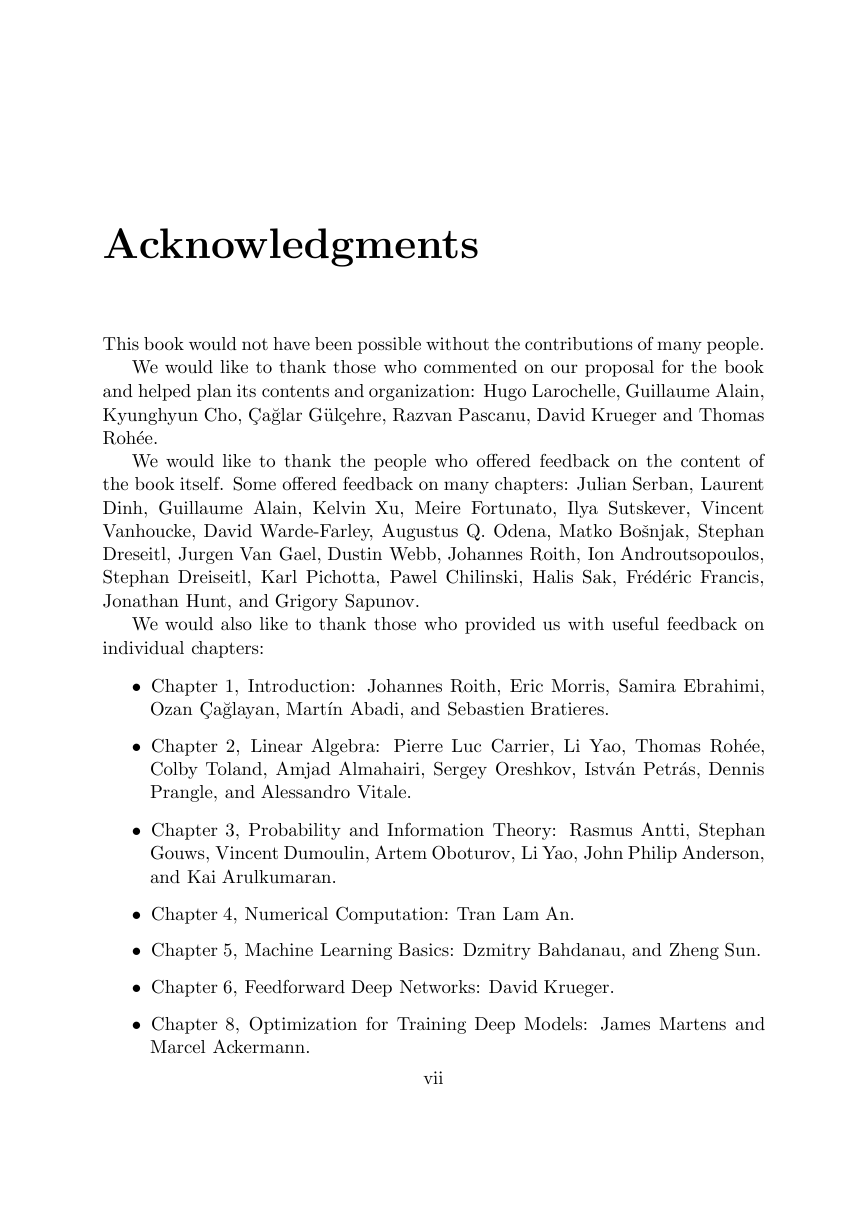
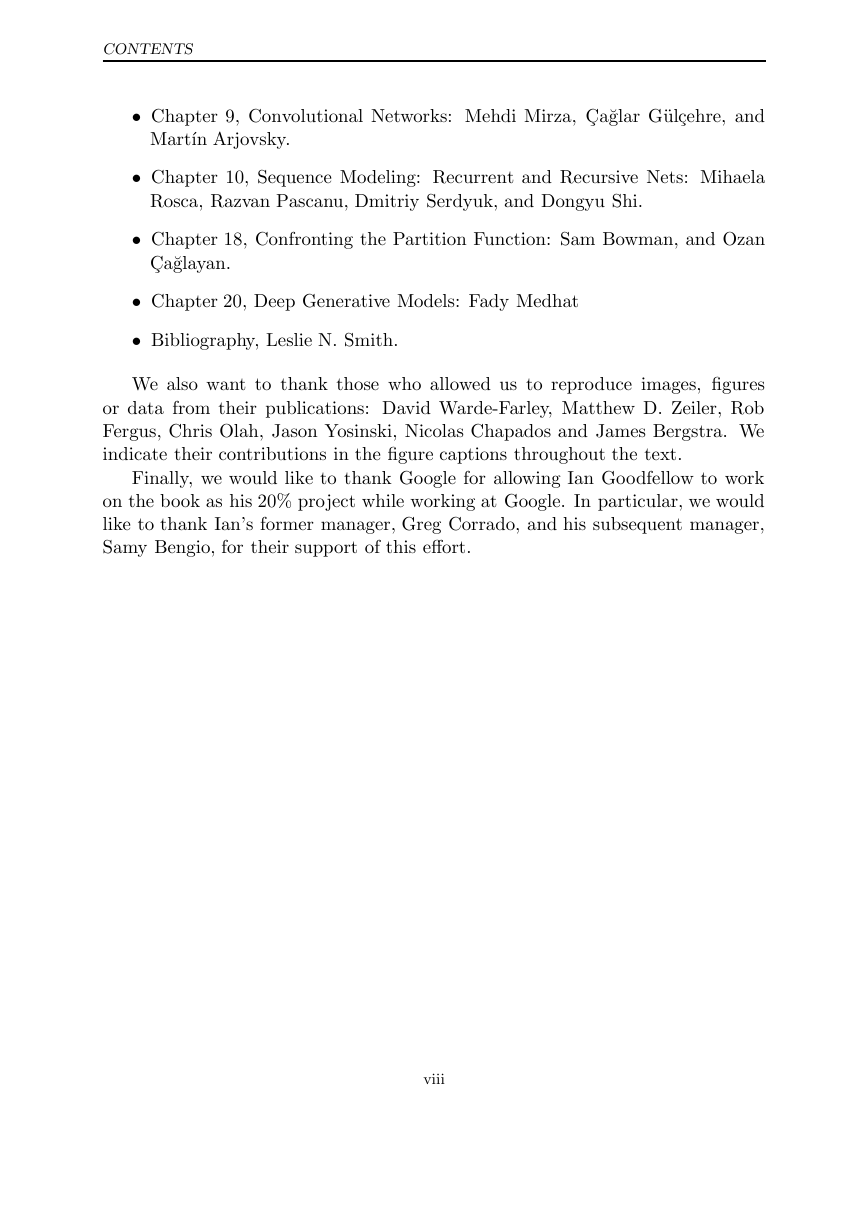








 2023年江西萍乡中考道德与法治真题及答案.doc
2023年江西萍乡中考道德与法治真题及答案.doc 2012年重庆南川中考生物真题及答案.doc
2012年重庆南川中考生物真题及答案.doc 2013年江西师范大学地理学综合及文艺理论基础考研真题.doc
2013年江西师范大学地理学综合及文艺理论基础考研真题.doc 2020年四川甘孜小升初语文真题及答案I卷.doc
2020年四川甘孜小升初语文真题及答案I卷.doc 2020年注册岩土工程师专业基础考试真题及答案.doc
2020年注册岩土工程师专业基础考试真题及答案.doc 2023-2024学年福建省厦门市九年级上学期数学月考试题及答案.doc
2023-2024学年福建省厦门市九年级上学期数学月考试题及答案.doc 2021-2022学年辽宁省沈阳市大东区九年级上学期语文期末试题及答案.doc
2021-2022学年辽宁省沈阳市大东区九年级上学期语文期末试题及答案.doc 2022-2023学年北京东城区初三第一学期物理期末试卷及答案.doc
2022-2023学年北京东城区初三第一学期物理期末试卷及答案.doc 2018上半年江西教师资格初中地理学科知识与教学能力真题及答案.doc
2018上半年江西教师资格初中地理学科知识与教学能力真题及答案.doc 2012年河北国家公务员申论考试真题及答案-省级.doc
2012年河北国家公务员申论考试真题及答案-省级.doc 2020-2021学年江苏省扬州市江都区邵樊片九年级上学期数学第一次质量检测试题及答案.doc
2020-2021学年江苏省扬州市江都区邵樊片九年级上学期数学第一次质量检测试题及答案.doc 2022下半年黑龙江教师资格证中学综合素质真题及答案.doc
2022下半年黑龙江教师资格证中学综合素质真题及答案.doc